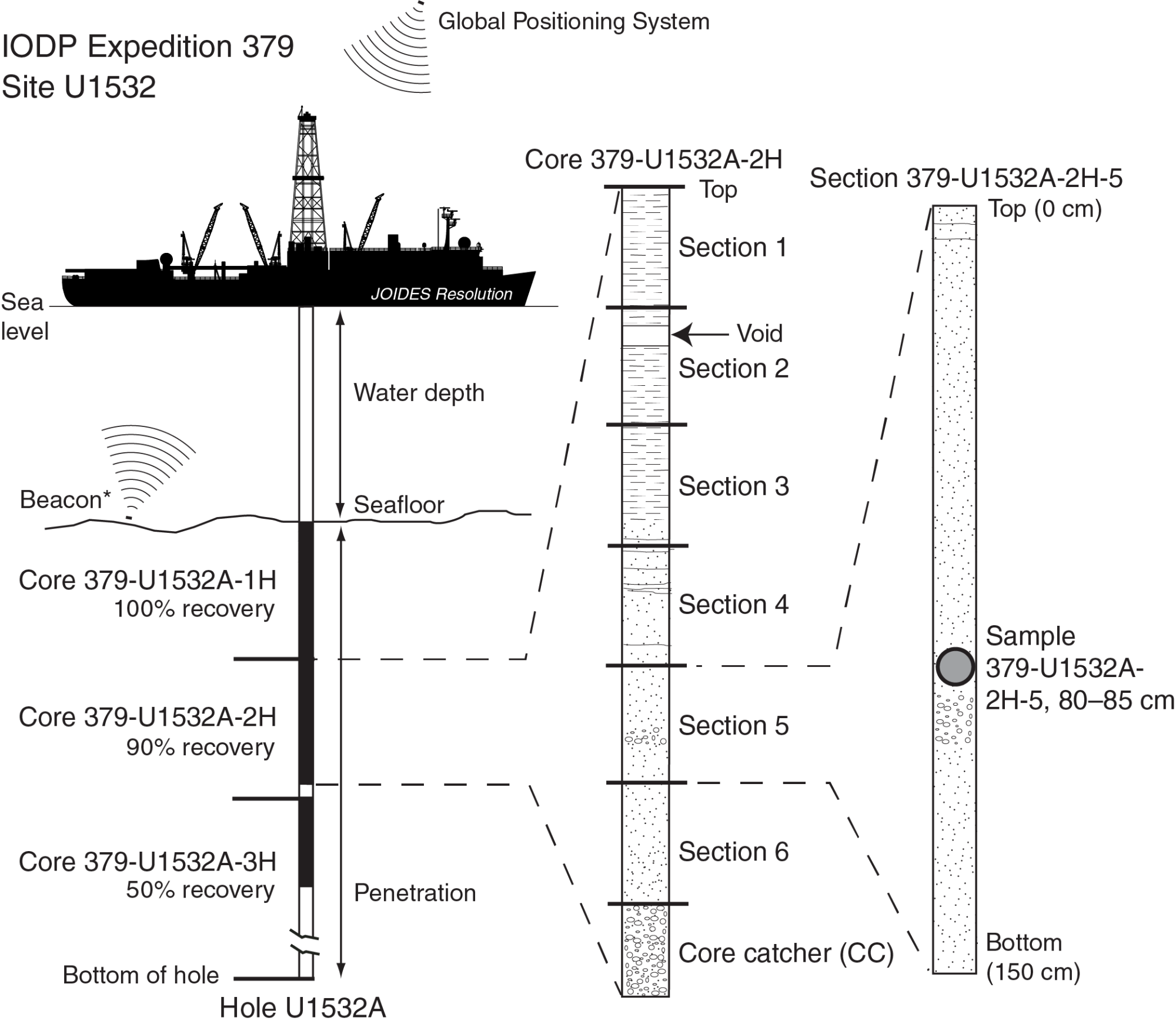
Many core samples are collected by the  JOIDES Resolution research vessel, as shown in this illustration from Expedition 379, co-authored by Johan Renaudie, one of the researchers in the micropaleontology laboratory of Museum für Naturkunde Berlin. Read more at:
http://publications.iodp.org/proceedings/379/102/379_102.html (03.01.2022).
JOIDES Resolution research vessel, as shown in this illustration from Expedition 379, co-authored by Johan Renaudie, one of the researchers in the micropaleontology laboratory of Museum für Naturkunde Berlin. Read more at:
http://publications.iodp.org/proceedings/379/102/379_102.html (03.01.2022).
Core samples are cylindrical sections of materials obtained by drilling with special drills through sediment and other substances. While this sampling technique is common across a great variety of applications, they are especially important in geological and earth sciences but also in climate sciences and paleoceanography.1 Cores from natural sediments are instrumental in the interpretation of underground features and for producing  data about the history of specific locations, and about the planet more generally. Techniques for drilling boreholes are ancient, but they remained rather rudimental for a long time. With the convergence of the geological sciences and the extractive industries in the 19th century, modern coring tools and techniques began to emerge. These early tools allowed only for relatively small and inaccurate samples, which also played a role in the
data about the history of specific locations, and about the planet more generally. Techniques for drilling boreholes are ancient, but they remained rather rudimental for a long time. With the convergence of the geological sciences and the extractive industries in the 19th century, modern coring tools and techniques began to emerge. These early tools allowed only for relatively small and inaccurate samples, which also played a role in the  micropaleontological evolutionary dead ends encountered in the second half of the 1800s. It was only in the late 1940s, when Swedish scientist Borje Kullenberg introduced the piston corer, that deeper and more coherent samples could be collected from the ocean floor.
micropaleontological evolutionary dead ends encountered in the second half of the 1800s. It was only in the late 1940s, when Swedish scientist Borje Kullenberg introduced the piston corer, that deeper and more coherent samples could be collected from the ocean floor.
This commenced a concerted effort to gather samples for  reconstructing the history and dynamics of the planet, like in the case of the
reconstructing the history and dynamics of the planet, like in the case of the  Lamont-Doherty Collection. These early undertakings gave momentum to
Lamont-Doherty Collection. These early undertakings gave momentum to  micropaleontology at sea, as vast transnational efforts to collect and collate core samples from the global ocean started
micropaleontology at sea, as vast transnational efforts to collect and collate core samples from the global ocean started  deep sea drilling. This monumental technoscientific and sociopolitical venture allows scientists to tell new stories
deep sea drilling. This monumental technoscientific and sociopolitical venture allows scientists to tell new stories  of microbes and planets, and to better understand planetary systems and the history of the Earth.2 Using
of microbes and planets, and to better understand planetary systems and the history of the Earth.2 Using  biostratigraphy and other more complex techniques and analytical tools, scientists can extract data about past climates, as well as atmospheric and oceanic compositions. With the help of
biostratigraphy and other more complex techniques and analytical tools, scientists can extract data about past climates, as well as atmospheric and oceanic compositions. With the help of  micropaleontological formations they can catch glimpses of the workings of our planet, like in the case of
micropaleontological formations they can catch glimpses of the workings of our planet, like in the case of  Cycladophora davisiana and
Cycladophora davisiana and  Foraminifera.
Foraminifera.
While scientists value the data that allows them to temporarily black-box their idiosyncratic specificities, the same data derives its power from the  situated stories that it emerges from. So, as data from core samples are used to produce accounts of the planet and its history, they can also bring to the surface other stories, like the ones gathered on this website. The complex
situated stories that it emerges from. So, as data from core samples are used to produce accounts of the planet and its history, they can also bring to the surface other stories, like the ones gathered on this website. The complex  technoscientific apparatus that allows us to tell such
technoscientific apparatus that allows us to tell such  stories relies on research vessels, large drills, core repositories, micropaleontological fossil records, and databases like the
stories relies on research vessels, large drills, core repositories, micropaleontological fossil records, and databases like the  NSB Database. Simultaneously, it also depends on the many lives – of scientists, animals, microorganisms, and many others – who enter in relation with it, and shape its ongoing development and transformation.
NSB Database. Simultaneously, it also depends on the many lives – of scientists, animals, microorganisms, and many others – who enter in relation with it, and shape its ongoing development and transformation.
A video showing the work of collecting and studying core samples through  Radiolaria on board of the deep sea drilling vessel
Radiolaria on board of the deep sea drilling vessel  JOIDES Resolution. (Source: The JOIDES Resolution/YouTube)
JOIDES Resolution. (Source: The JOIDES Resolution/YouTube)
- You can learn more about core samples also by exploring the mineralogical collections of the Museum für Naturkunde Berlin: https://www.museumfuernaturkunde.berlin/en/science/geochemical-and-microanalytical-laboratories (03.01.2022) and https://www.museumfuernaturkunde.berlin/en/science/rock-and-ore-collection (03.01.2022).↩
- Arranging international research efforts of this scale is not an easy task, and is one that requires complex sociopolitical arrangements. To learn more on the work of extracting data from the ocean’s depths, see Christof Rosol. “Hauling Data: Anthropocene Analogues, Paleoceanography and Missing Paradigm Shifts“. Historical Social Research 40, no. 2 (2015): 37-66. https://doi.org/10.12759/hsr.40.2015.2.37-66.↩